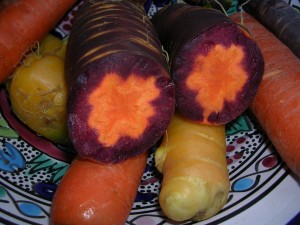Learn how to grow carrots including information on good varieties to try.
Listen to Podcast:
When I first traveled to northern India 20 years ago, I was amazed to see red, yellow, white, and purple colored carrots (Daucus carota), but no orange carrots. In fact, those are the native colors of carrots and it was the Dutch in the 1700s that popularized the color orange (after their national flag) as the modern color of carrots. We’ve been eating orange carrots ever since, but now those old colors have returned.
Carrots may be a little finicky to get going for a beginning gardener, but the rewards are plenty. The sweet, crunch roots are perfect eaten raw, roasted, sauteed, made into soup, juiced, or used in dips. Plus, kids love them. It’s like a treasure hunt when it’s time to harvest carrots.
If you’ve never tasted a fresh carrot picked right out of the garden, you’ll be amazed at the sweetness. Carrots grow well in small spaces and containers, too. There are even diminutive varieties that fit perfect in a pot.
If you’re looking for a healthy vegetable, go no further than the carrot. It’s loaded with vitamin A and beta-carotene, both known anti-oxidants and cancer fighters.
When to Plant
Although they grow best with temperatures in the 60Fs, carrots can hold in the garden all summer. That’s the beauty of this vegetable. Spring planted carrots can be enjoyed in mid summer through fall. Simply pull and eat the carrots as you need them. Sow seeds, in April or early May, 2 to 4 weeks before your last frost date. In warmer parts of our region, sow again in mid summer for an additional fall harvest.
Where to Plant
Carrots are root crops and need a loose, sandy, well-drained garden bed to grow in. I think raised beds are best. Although they’ll grow best in full sun, they can produce even with only 3 to 4 hours of sun a day. Carrots also grow well in containers and even window boxes.
How to Plant
Proper soil preparation is key to growing great carrots. If the soil is too heavy, has too many sticks, stones and debris in it, the carrots will not grow to full size or will be deformed. Build a raised bed 8 inches tall, 3 feet wide and as long as you wish. Remove any debris and smooth the top of the bed flat. Sow seeds either in rows spaced 18 inches apart or broadcast seed over the whole raised bed. Since carrot seed is so small you’ll probably over plant. That’s okay because by thinning, so you achieve the proper spacing of the carrot plants. I like to sprinkle the seeds on the top of the bed and cover them with a 1/4 inch thick layer of potting soil or sand. This allows the seeds to be protected from drying out, but offers an easy medium for them to grow through. If planted too deep, the carrot seed may not have the strength to break through the soil. There is pelleted carrot seed available that is coated with clay making for a larger seeds that’s easy to space properly. These are great for kids and gardeners with a small planting.
Care and Maintenance
Be patient with your carrots. They may take up to 2 to 3 weeks to germinate. Keep the bed consistently moist during that time. I like to cover it with a floating row cover to help maintain the soil moisture. Once germinated, just remove the cover.
The biggest reason why gardeners have spindly carrots is they don’t thin early and often enough. Thin carrots once they germinate to 1- to 2-inches apart. Thin again 3 weeks later to 3- to 4-inches apart. It will look like you pulled all your plants, but don’t fear. The remaining carrots will fill in the voids and mature to full size.
Keep the bed consistently moist by watering regularly. Carrots don’t compete well with weeds, so pull the weeds while you’re thinning as well. Mulch the pathways in between beds with straw. Cover any carrot root tops that are exposed with soil so they don’t turn green. Although the green on carrots isn’t harmful, it doesn’t taste good.
Carrots can have a number of different problems, all solvable. Forked or spindly roots are due to debris in the soil, improper thinning, or too much nitrogen fertilizer. Unless your soil is very poor, avoid adding much nitrogen fertilizer in the form of compost or bagged fertilizer. The carrot rust fly can lay eggs on carrot tops and the larvae will tunnel in the upper portions of carrot roots. Cover the carrot bed with a floating row cover to avoid this pest.
Rabbits and woodchucks love carrot tops almost as much as beans. Fence the carrot bed well, burying the fence in the soil so these critters can’t tunnel under it.
Harvest
You can begin harvesting carrots as soon as the roots show color — as early as right after the second thinning. Harvest
while the soil is moist so the carrots are easier to pull out. If you break the top when pulling, don’t worry. Gently dig with a hand trowel around the root to pry it out.
Dig as many carrots as you need to eat. Carrots will take a frost and actually the flavor gets sweeter with cool weather in fall. If you really want to store your carrots in the ground, bury the carrot bed in November with a 6- to 8-inch thick layer of hay. You’ll be able to dig through the hay and snow in winter and harvest carrots still fresh in the soil. They’ll be as sweet as candy.
Additional Information
‘Napoli Hybrid’, ‘Yaya Hybrid’, ‘Scarlet Nantes’, and ‘Danvers’ are all good orange varieties to try in our region. ‘Yellowstone’ is a good golden variety, ‘Cosmic Purple’ and ‘Deep Purple’ are good purple varieties. ‘Atomic Red’ is a good red variety, and ‘White Satin Hybrid’ is a good white variety. For small spaces and containers, try ‘Thumbelina’, which grows in the shape of a one-half dollar coin, and ‘Kinko’ Hybrid’ which produces 4-inch long, tasty, orange roots.
Excepted from Northeast Vegetable and Fruit Gardening.
Podcast Transcript
This vegetable has a reputation for providing great vision and a long life. During World War II the British disguised the fact they were employing radar to shoot down German bombers by saying their pilots possessed superior night vision by eating carrots. Industrialist Henry Ford loved carrots almost as much as cars believing they extended your life. He once presided over a 12-course meal featuring carrot soup, mousse, salad, pickled carrots, carrots au gratin, carrot loaf and carrot ice cream all washed down with carrot juice.
Carrots are one of our most common vegetables, and the varieties now available harken back to its roots in Central Asia. The original carrot is actually a scrawny red or purple colored root. It was only after Dutch breeding in the 16th century that the orange carrot we now know became so popular. Now we have many orange varieties for many uses such as the silver dollar sized ‘Thumbelina’, pest resistant ‘Fly Away’ and high betacarotene ‘Healthmaster’. Plus, there are newer versions of the purple, red, yellow and white varieties, too. I find the purple and red varieties are tastier cooked than eaten raw.
To grow carrots, prepare a raised bed amended with a little compost and sow the small seeds in rows or broadcast across the top of the bed. You might consider using pelleted seed or a seed tape for proper spacing. Cover the seed lightly with potting soil and keep well watered. Mix some radish seed in with the carrots. The radishes will germinate fast breaking up the soil and making it easier for carrots to grow. Thin carrots after germination to 2 inches apart and again in 3 weeks to 4 inches apart. Use the thinned tops and roots in salads. Plant successive crops all summer for a continuous crop right into winter.




